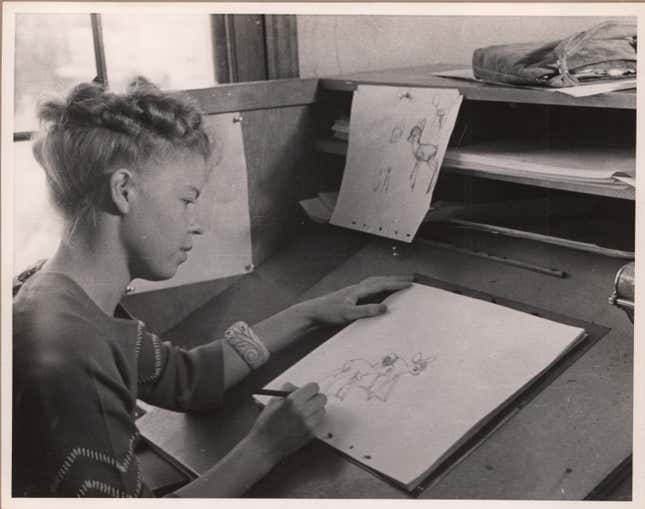How Disney's First Woman Animator Broke Into the Boys' Club
In Depth

Below is an excerpt from The Queens of Animation. In the book, Nathalia Holt traces the careers of the women who broke into the vaunted animation department at Disney in its earliest days, shaping landmark elements of the company’s history from Fantasia’s “Waltz of the Flowers” to the look and feel of Dumbo and Bambi. Holt—who is also the author of Rise of the Rocket Girls, about the women who worked as “human computers” at the Jet Propulsion Laboratory at the dawn of the space age—follows their influence all the way through to the blockbuster Frozen. This despite many, many challenges and assumptions, exemplified in this excerpt by the literal boys’ club on the roof of the building where they worked.
The artists working on Bambi gathered around a pile of sketches. No one knew where the drawings had come from, but all agreed that they were terrifying. The hunting dogs seemed to leap off the page with thick, muscular bodies and arresting eyes. In the sketches, the snarling beasts corner the doe Faline. Bambi then charges in, using his antlers to fend off the vicious animals in scenes that burst with action: the dogs’ backs arch in pain and Bambi’s antlers are framed perfectly in each shot to highlight their strength. The artists looked at one another and asked, “Who did this? Whose drawings are these?” The animators all assumed that the mystery artist was a man. Still, no one took credit. It seemed as though the sketches had fallen from the sky. Then Retta Scott walked in. Here was their culprit: not a man at all but a young woman with blond curls piled on top of her head, and a host of ideas on how to make the attacking animals even more frightening.
Walt Disney Studios had just moved into its new home in Burbank, and for Retta the move had not come a moment too soon. The story group working on Bambi back on Hyperion Avenue had been relegated to a small outbuilding on Seward Street that they called, not affectionately, “Termite Terrace,” as its walls had started curving inward, literally crumbling in place. The Burbank studio, in contrast, was like a palace with its three-story Streamline Moderne design. Walt had personally worked on the architectural plans, helping to create a massive eight-wing building, formed from two side-by-side H- shaped structures with plenty of windows, so that natural light flowed into the offices. The animators and concept artists worked on the ground floor; directors, background, and layout artists on the second; with the story department and Walt’s office on the third floor.
If you took a private elevator up to the roof, however, you entered an entirely different world. Getting off the lift, one was confronted by a mural of fourteen nude women surrounding a single man on the wall next to the door. Known as the Penthouse Club, the space offered a bar and restaurant, barbershop, massage table, gym, steam baths, beds, billiard and card tables, as well as a large uncovered area popular for nude sunbathing. The exclusively male club required substantial dues and a strict selection process to join. An employee had to make more than two hundred dollars a week, a level attained by only a small number of animators. It was a new era of elitism at the studio, one that rankled for many of the artists, who had previously viewed their group, crammed together in ramshackle buildings on Hyperion Avenue, as a family.
Retta worked on the third floor, creating her sketches for Bambi as part of the story department. Walt was finally turning his attention back to the forest feature, confessing, “I haven’t felt that Bambi was one of our productions.” When Bianca Majolie had first started writing story treatments for the film, based on the novel, four years previously, she had noted its message of peace, and the beauty inherent in its descriptions of the natural world. But the book also had a political message that was even more necessary now that war was escalating in Europe and Asia.

Devastation was spreading across the globe in 1940, but the United States was shutting its eyes. Felix Salten, the author of Bambi, however, had always been conscious of surrounding danger. Born in 1869, Salten was the grandson of an orthodox rabbi. When he was only a month old, his family, seeking acceptance of their Jewish faith, moved from what is today Budapest, Hungary, to Vienna, Austria. Following the age of enlightenment that pervaded eighteenth-century Europe, in 1867 the city had begun granting citizenship to its Jewish residents, something many European cities had always refused to do. This sparked a mass migration of Jews to Vienna in search of social and economic opportunities.
As a young artist, Salten was a passionate Zionist, writing articles and giving speeches advocating the relocation of Jews to Palestine. When the Nazis banned his book in 1936, they declared the work “a political allegory on the treatment of Jews in Germany.” They were only partially correct; the meaning of Salten’s work goes far deeper.
In Bambi: A Life in the Woods, Salten illustrates the dangers of cultural assimilation. Several animals in the book advocate gaining mercy from humans by bending to their will and joining forces with them. For the animals who submit to the cruel hunters, however, things do not work out well. Gobo, a sickly young buck, tells Bambi, “I don’t need to be afraid of them anymore. I’m good friends with them now.” Gobo believes that the collar he wears around his neck will keep him safe. This proves to be false when he naively approaches a hunter in the meadow who shoots him dead. Even the vicious dogs that Retta sketched with such skill play complex roles in Salten’s book, as animal collaborators to the very hunters they despise. Bambi’s father describes their beliefs this way: “They pass their lives in fear, they hate [Man] and themselves and yet they’d die for His sake.” It was no coincidence that Bambi was finally coming to fruition at the studio in 1940. The story was a response to the rise of fascism, one that those employees who closely followed events abroad felt fervent about telling.
When Walt saw Retta’s sketches for Bambi, made as part of her work developing the script, he was so overwhelmed by her talent that he decided to do something unprecedented. He made Retta an animator. She was the first woman to join the elite group. If the story department was “the heart of organization,” as Walt said, then the animators were the lifeblood coursing through it, each artist handpicked by Walt. Becoming an animator was no minor accomplishment. Many men and some women worked as “inbetweeners,” cleaning up the animators’ drawings, and making the repetitive sketches that linked together their work and gave the characters movement. It was a job that someone might occupy for years before becoming an assistant animator, and eventually a character animator. Even those who made it to the top had to consistently perform in order to maintain their position. Retta knew that her prowess in the story department had steered her into a spot only a select few were allowed to occupy.
An in-house write-up of Retta’s promotion read jokingly, “The Animators had always hoped that their pleasurable existence wouldn’t be marred by the entrance of a mere girl into their working lives.” Retta reported to her new department only to find that her male colleagues had mockingly decorated the space for her, hanging ruffled, feminine curtains and placing a lace doily on her chair.
Excerpted from the book THE QUEENS OF ANIMATION: THE UNTOLD STORY OF THE WOMEN WHO TRANSFORMED THE WORLD OF DISNEY AND MADE CINEMATIC HISTORY by Nathalia Holt. Copyright © 2019 by Nathalia Holt. Reprinted with permission of Little, Brown and Company. All rights reserved.